Abstract
To characterize the epidemiology of dysentery (defined as bloody diarrhoea) in Burundi, we reviewed national surveillance data and conducted a household cluster survey including two case--control studies: one at the household, the other at the individual level. We estimated that community incidences for dysentery (per 1000 residents) in Kibuye Sector were 15.3 and 27.3, and that dysentery accounted for 6% and 12% of all deaths, in 1991 and 1992, respectively. Factors associated (P < or = 0.05) with contracting dysentery were being female, using a cloth rag after defecation, a history of recent weight loss, and not washing hands before preparing food. The attributable risk, at the household level, of not washing hands before preparing food was 30%. Secondary household transmission accounted for at most 11% of dysentery cases. This study suggests that Shigella dysenteriae type 1 may be one of the leading causes of preventable mortality in Burundi and other African countries where effective antimicrobial agents are no longer affordable. Since hands were the most important mode of transmission of S. dysenteriae in this study, community-based interventions aimed at increasing hand washing with soap and water, particularly after defecation and before food preparation, may be effective for controlling dysentery epidemics caused by S. dysenteriae type 1 in Africa.
Full text
PDF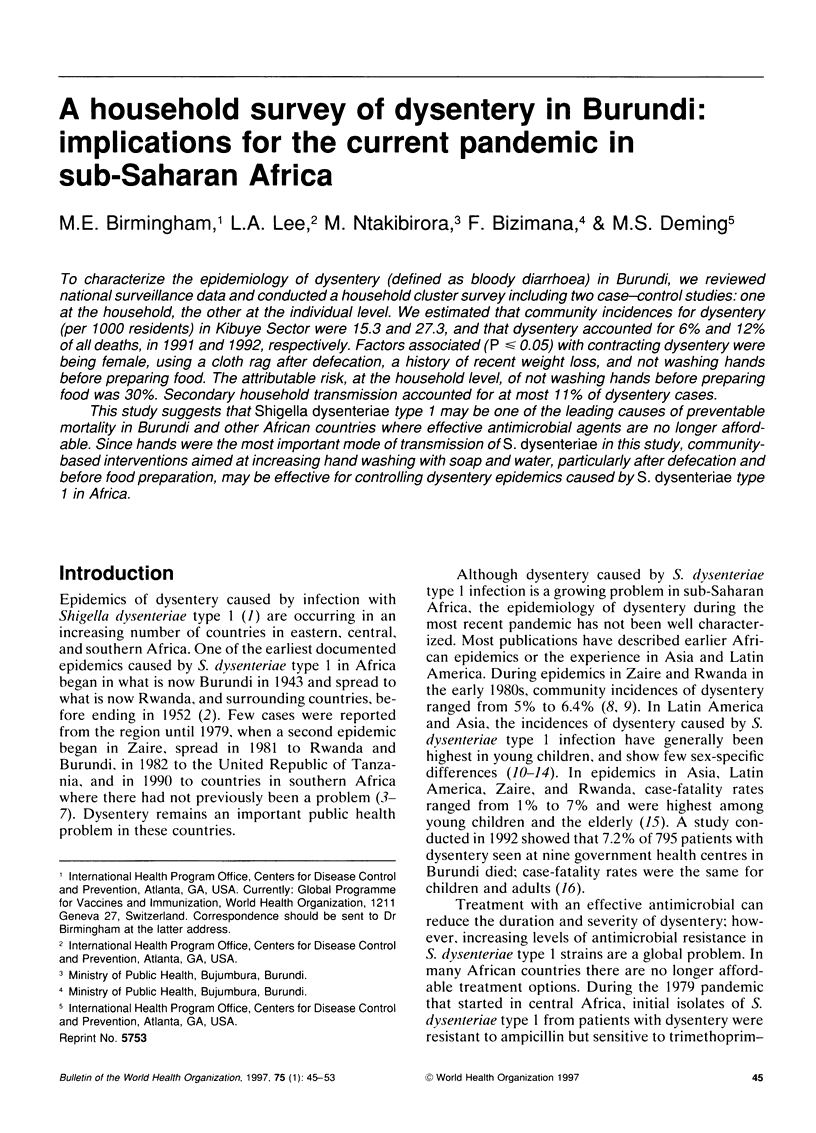
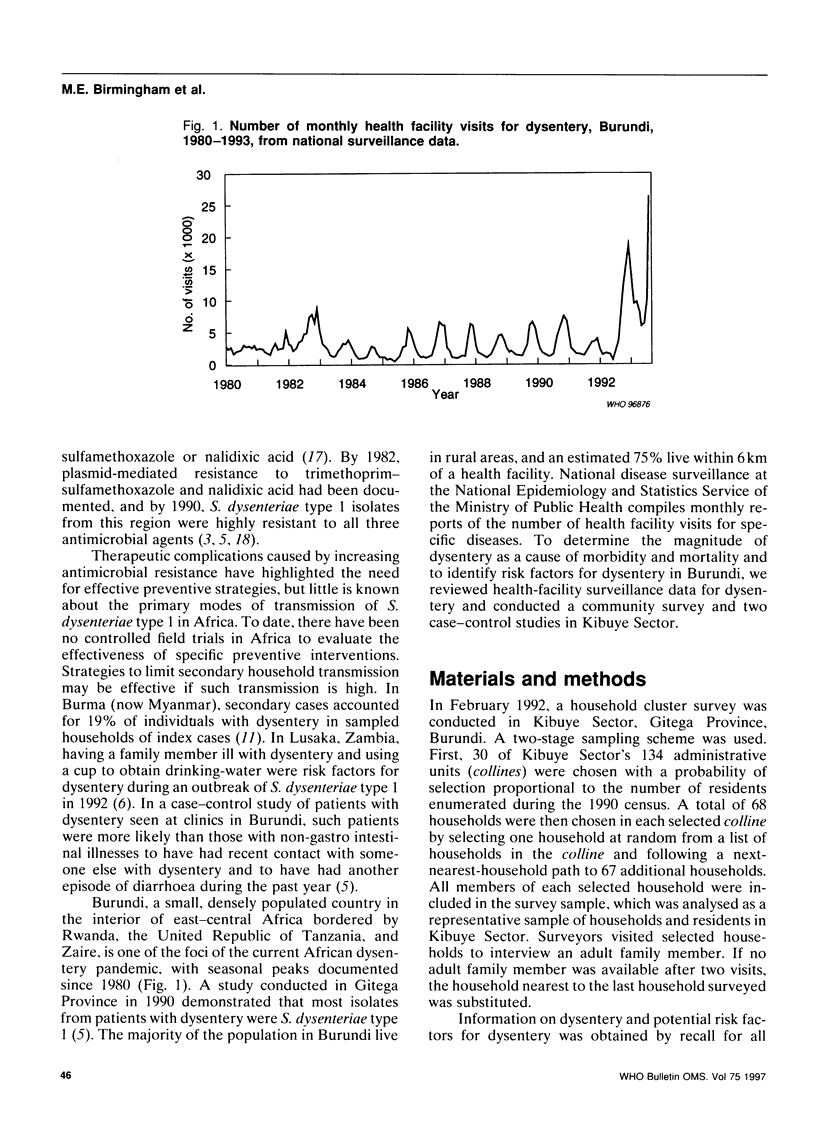


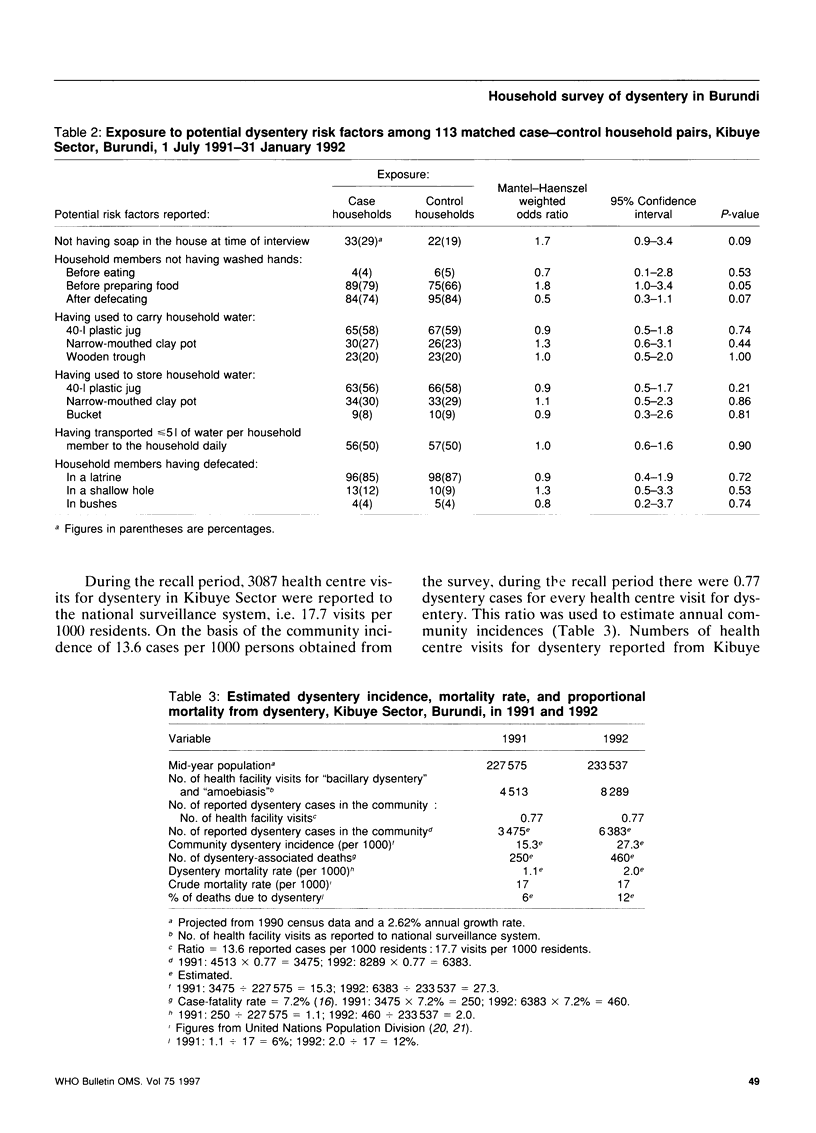
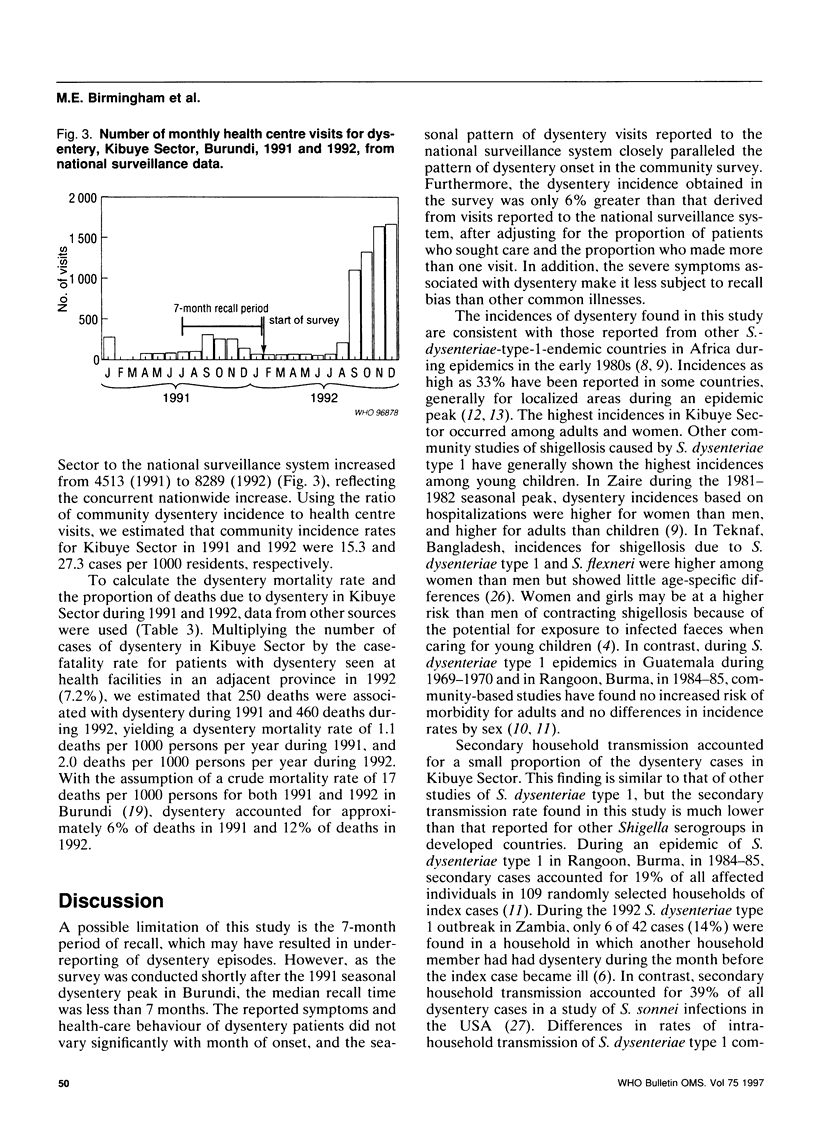
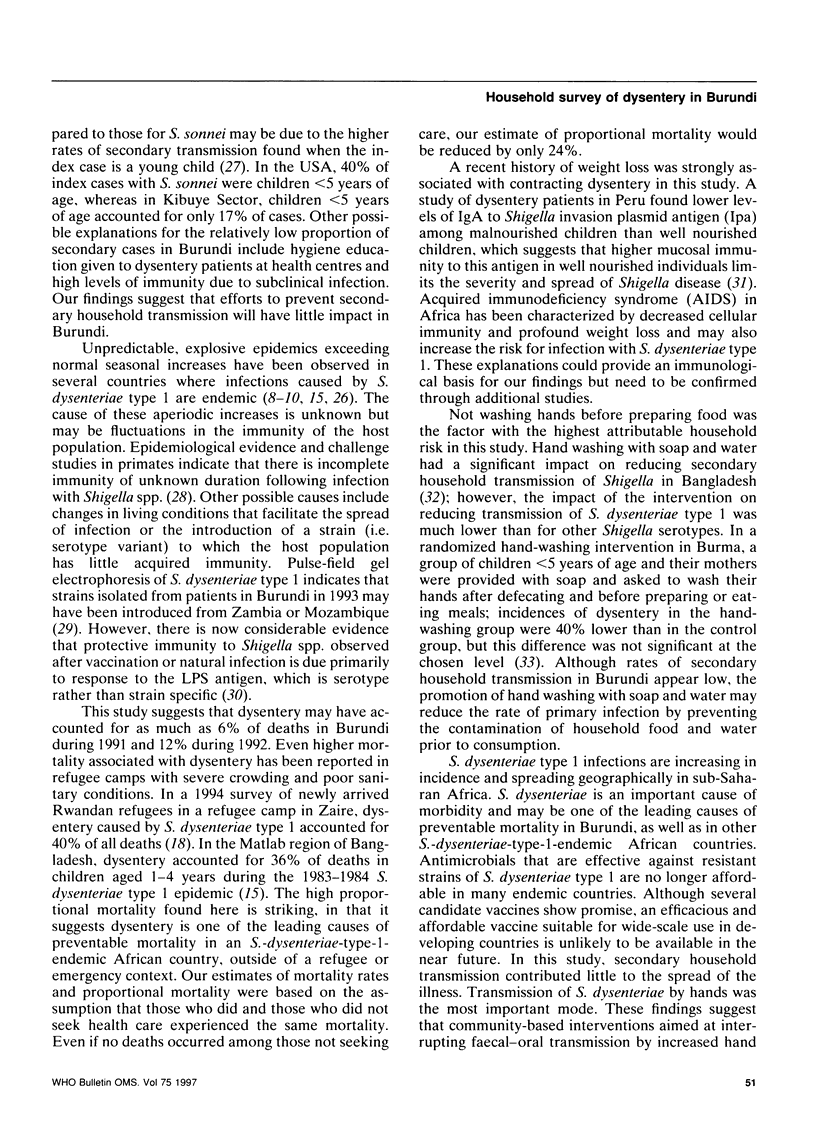
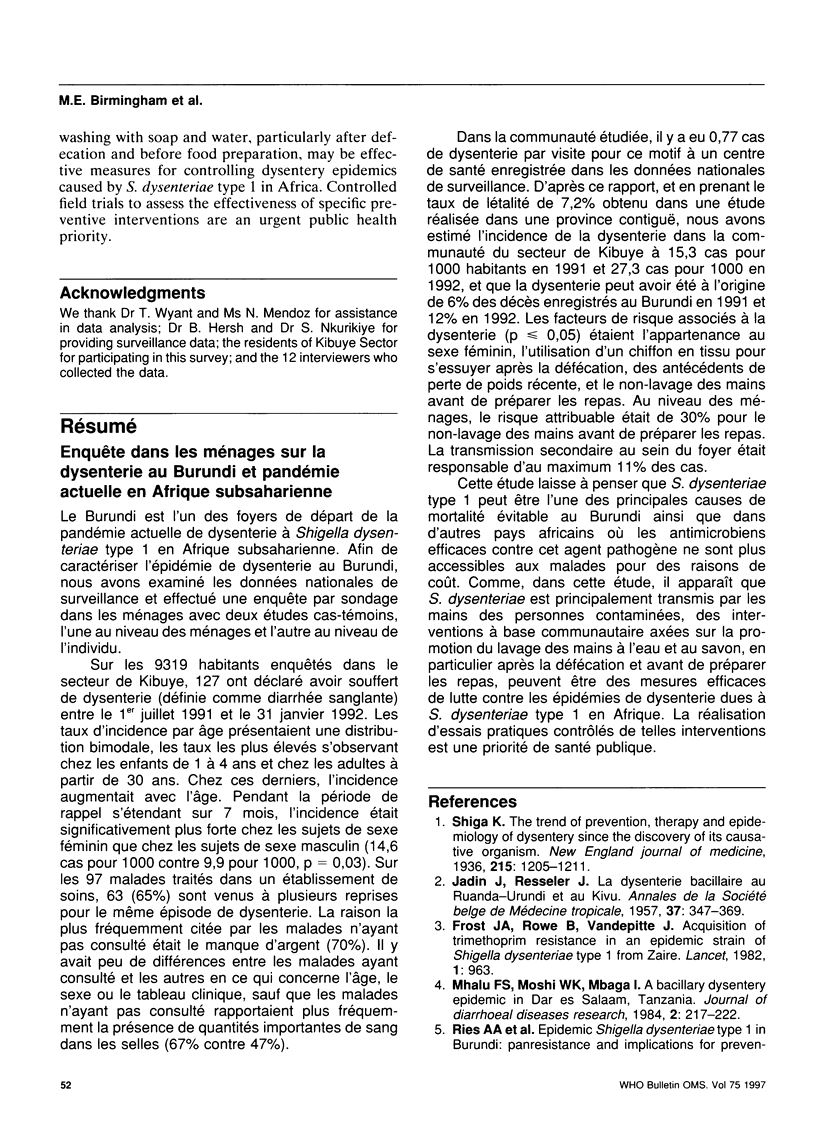

Selected References
These references are in PubMed. This may not be the complete list of references from this article.
- Aung Myo Han, Thein Hlaing Prevention of diarrhoea and dysentery by hand washing. Trans R Soc Trop Med Hyg. 1989 Jan-Feb;83(1):128–131. doi: 10.1016/0035-9203(89)90737-2. [DOI] [PubMed] [Google Scholar]
- Bennish M. L., Wojtyniak B. J. Mortality due to shigellosis: community and hospital data. Rev Infect Dis. 1991 Mar-Apr;13 (Suppl 4):S245–S251. doi: 10.1093/clinids/13.supplement_4.s245. [DOI] [PubMed] [Google Scholar]
- Bruzzi P., Green S. B., Byar D. P., Brinton L. A., Schairer C. Estimating the population attributable risk for multiple risk factors using case-control data. Am J Epidemiol. 1985 Nov;122(5):904–914. doi: 10.1093/oxfordjournals.aje.a114174. [DOI] [PubMed] [Google Scholar]
- Frost J. A., Rowe B., Vandepitte J. Acquisition of trimethoprim resistance in epidemic strain of Shigella dysenteriae type 1 from Zaire. Lancet. 1982 Apr 24;1(8278):963–963. doi: 10.1016/s0140-6736(82)91960-2. [DOI] [PubMed] [Google Scholar]
- Gangarosa E. J., Perera D. R., Mata L. J., Mendizábal-Morris C., Guzmán G., Reller L. B. Epidemic Shiga bacillus dysentery in Central America. II. Epidemiologic studies in 1969. J Infect Dis. 1970 Sep;122(3):181–190. doi: 10.1093/infdis/122.3.181. [DOI] [PubMed] [Google Scholar]
- Hale T. L., Keren D. F. Pathogenesis and immunology in shigellosis: applications for vaccine development. Curr Top Microbiol Immunol. 1992;180:117–137. doi: 10.1007/978-3-642-77238-2_6. [DOI] [PubMed] [Google Scholar]
- Han A. M., Aye T., Hlaing T. An outbreak of dysentery due to Shigella dysenteriae type 1 in Rangoon, Burma. J Diarrhoeal Dis Res. 1987 Mar;5(1):30–35. [PubMed] [Google Scholar]
- Hossain M. A., Albert M. J., Hasan K. Z. Epidemiology of shigellosis in Teknaf, a coastal area of Bangladesh: a 10-year survey. Epidemiol Infect. 1990 Aug;105(1):41–49. doi: 10.1017/s0950268800047622. [DOI] [PMC free article] [PubMed] [Google Scholar]
- Huppertz H. I. An epidemic of bacillary dysentery in western Rwanda 1981-1982. Cent Afr J Med. 1986 Mar;32(3):79–82. [PubMed] [Google Scholar]
- JADIN J., RESSELER J. La dysenterie bacillaire au Ruanda-Urundi et au Kivu. Ann Soc Belg Med Trop (1920) 1957 Jun 30;37(3):347–369. [PubMed] [Google Scholar]
- Malengreau M., Molima-Kaba, Gillieaux M., de Feyter M., Kyele-Duibone, Mukolo-Ndjolo Outbreak of Shigella dysentery in Eastern Zaire, 1980-1982. Ann Soc Belg Med Trop. 1983 Mar;63(1):59–67. [PubMed] [Google Scholar]
- Mathan V. I., Bhat P., Kapadia C. R., Ponniah J., Baker S. J. Epidemic dysentery caused by the Shiga bacillus in a southern Indian village. J Diarrhoeal Dis Res. 1984 Mar;2(1):27–32. [PubMed] [Google Scholar]
- Mhalu F. S., Moshi W. K., Mbaga I. A bacillary dysentery epidemic in Dar es Salaam, Tanzania. J Diarrhoeal Dis Res. 1984 Dec;2(4):217–222. [PubMed] [Google Scholar]
- Phalipon A., Sansonetti P. Live attenuated Shigella flexneri mutants as vaccine candidates against shigellosis and vectors for antigen delivery. Biologicals. 1995 Jun;23(2):125–134. doi: 10.1006/biol.1995.0023. [DOI] [PubMed] [Google Scholar]
- Rahaman M. M., Khan M. M., Aziz K. M., Islam M. S., Kibriya A. K. An outbreak of dysentery caused by Shigella dysenteriae type 1 on a coral island in the Bay of Bengal. J Infect Dis. 1975 Jul;132(1):15–19. doi: 10.1093/infdis/132.1.15. [DOI] [PubMed] [Google Scholar]
- Robins J., Greenland S., Breslow N. E. A general estimator for the variance of the Mantel-Haenszel odds ratio. Am J Epidemiol. 1986 Nov;124(5):719–723. doi: 10.1093/oxfordjournals.aje.a114447. [DOI] [PubMed] [Google Scholar]
- Rogerie F., Vimont-Vicary P. Etude bactériologique des shigelloses dans la région du lac Kivu (Afrique centrale). Evolution au cours des quinze dernières années (1968-1983). Bull Soc Pathol Exot Filiales. 1986;79(4):435–446. [PubMed] [Google Scholar]
- Sengupta P. G., Mandal S., Sen D., Das P., Deb B. C., Pal S. C. Multidrug resistant epidemic shigellosis in a village in west Bengal, 1984. Indian J Public Health. 1990 Jan-Mar;34(1):15–19. [PubMed] [Google Scholar]
- Tuttle J., Ries A. A., Chimba R. M., Perera C. U., Bean N. H., Griffin P. M. Antimicrobial-resistant epidemic Shigella dysenteriae type 1 in Zambia: modes of transmission. J Infect Dis. 1995 Feb;171(2):371–375. doi: 10.1093/infdis/171.2.371. [DOI] [PubMed] [Google Scholar]


